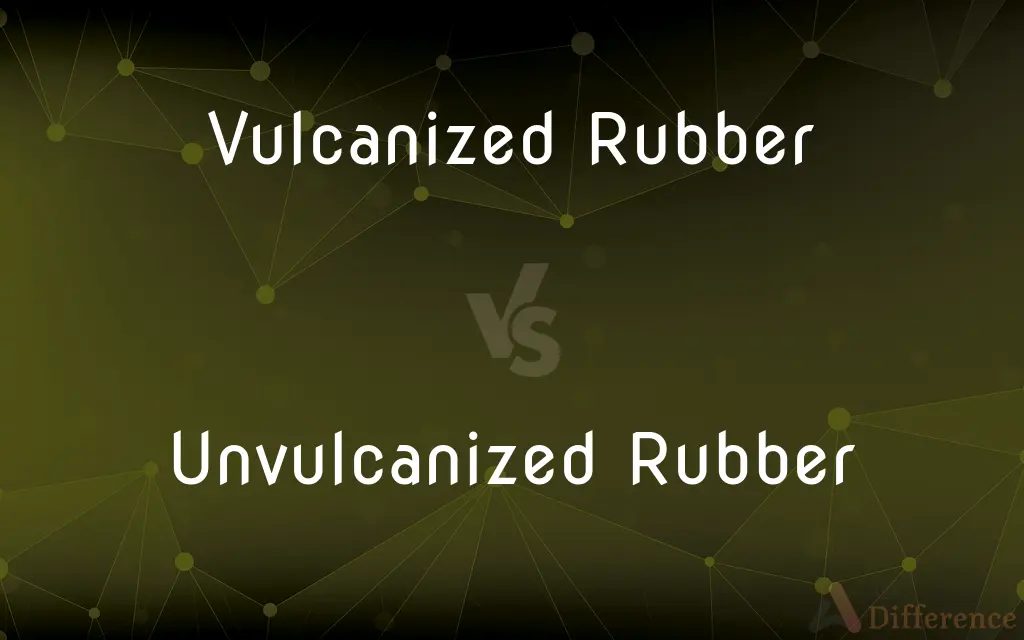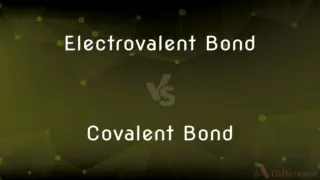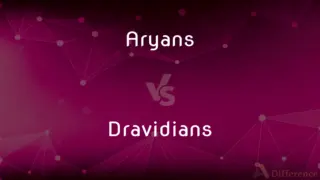Vulcanized Rubber vs. Unvulcanized Rubber — What's the Difference?
By Tayyaba Rehman — Published on January 14, 2024
Vulcanized rubber is chemically treated for enhanced durability and elasticity; unvulcanized rubber is in its raw, untreated form.

Difference Between Vulcanized Rubber and Unvulcanized Rubber
Table of Contents
ADVERTISEMENT
Key Differences
Vulcanized rubber has undergone a chemical process involving sulfur, which creates cross-links between polymer chains to enhance properties like strength, elasticity, and resistance to solvents and temperature changes. Unvulcanized rubber lacks these cross-links and thus these properties.
Unvulcanized rubber is softer and more malleable than vulcanized rubber, which makes it easier to work with in manufacturing processes that shape the rubber. However, without vulcanization, the rubber remains sensitive to temperature changes and can become sticky or brittle.
The vulcanization process was invented by Charles Goodyear and involves heating raw rubber with sulfur. This process transforms the rubber to a more durable material, which allows for its use in a variety of products like tires and industrial belts. Unvulcanized rubber cannot be used in these applications due to its lack of strength.
Vulcanized rubber can withstand harsh conditions and is used in products that require high durability and resistance to wear and tear. Conversely, unvulcanized rubber is often used in the initial stages of production before the rubber is vulcanized, or for products that do not require enhanced material properties.
The differences between vulcanized and unvulcanized rubber are significant in terms of their physical properties and their uses in industry. Vulcanized rubber, being more robust, finds a place in the automotive and footwear industries, while unvulcanized rubber is typically seen in less demanding applications.
ADVERTISEMENT
Comparison Chart
Chemical Structure
Has sulfur cross-links between polymers
Lacks sulfur cross-links
Durability
Highly durable and resistant to wear
Less durable and prone to wear
Elasticity
Increased elasticity
Lower elasticity
Temperature Resistance
Resistant to extreme temperatures
Sensitive to temperature changes
Usage in Products
Used in tires, belts, footwear
Used before final shaping and vulcanizing
Compare with Definitions
Vulcanized Rubber
Rubber that is less reactive to chemicals.
Chemical handling gloves are made of vulcanized rubber for protection.
Unvulcanized Rubber
Rubber in its natural, tacky state.
Adhesives may contain unvulcanized rubber for its stickiness.
Vulcanized Rubber
Rubber treated with sulfur to improve resilience.
Car tires are made from vulcanized rubber to withstand road wear.
Unvulcanized Rubber
Raw rubber without chemical treatment for hardening.
Mats are initially produced using unvulcanized rubber.
Vulcanized Rubber
Heat-treated rubber with increased toughness.
Conveyor belts are often made from vulcanized rubber.
Unvulcanized Rubber
Soft rubber that's sensitive to temperature changes.
Unvulcanized rubber becomes sticky on hot days.
Vulcanized Rubber
Rubber that won’t melt or get brittle easily.
Seals and gaskets are typically made of vulcanized rubber.
Unvulcanized Rubber
Material used for products not requiring high durability.
Erasers are often made from unvulcanized rubber.
Vulcanized Rubber
Material with enhanced elasticity and strength.
Vulcanized rubber is used in shoe soles for durability.
Unvulcanized Rubber
Pliable rubber used before final manufacturing stages.
Unvulcanized rubber is molded into various shapes before vulcanizing.
Common Curiosities
How does vulcanization affect rubber's properties?
It greatly increases its strength, elasticity, and resistance to temperature and chemicals.
Is vulcanized rubber environmentally friendly?
It can be less eco-friendly due to its chemical process and durability, making it harder to decompose.
What is vulcanized rubber?
It's rubber that has been chemically treated with sulfur to improve its properties.
Why was vulcanized rubber a significant invention?
It allowed for the creation of durable rubber goods, greatly expanding rubber's applications.
Can vulcanized rubber revert to its unvulcanized state?
No, the vulcanization process is irreversible.
Is unvulcanized rubber cheaper than vulcanized rubber?
Typically, yes, because it requires less processing.
Why is vulcanized rubber preferred for tires?
Because of its durability, elasticity, and resistance to harsh conditions.
What is unvulcanized rubber used for?
It's used in the production process before rubber is vulcanized or for less demanding products.
Can unvulcanized rubber be used for outdoor products?
Generally no, because it doesn't handle temperature variations well.
Are there any health risks associated with vulcanized rubber?
There can be, particularly if it contains certain additives or during the vulcanization process.
Are there different methods of vulcanization?
Yes, there are several, including hot air, steam, and sulfur curing.
Can vulcanized rubber be recycled?
Yes, though it is a more complex process than recycling unvulcanized rubber.
Does unvulcanized rubber have any advantages over vulcanized?
Its malleability makes it easier to work with in the production process.
Can both types of rubber be colored and shaped as desired?
Yes, both can be manipulated in terms of color and shape, but vulcanized rubber maintains its form better after shaping.
What happens to unvulcanized rubber in cold temperatures?
It can become brittle and crack.
Share Your Discovery

Previous Comparison
Electrovalent Bond vs. Covalent Bond
Next Comparison
Aryans vs. DravidiansAuthor Spotlight
Written by
Tayyaba RehmanTayyaba Rehman is a distinguished writer, currently serving as a primary contributor to askdifference.com. As a researcher in semantics and etymology, Tayyaba's passion for the complexity of languages and their distinctions has found a perfect home on the platform. Tayyaba delves into the intricacies of language, distinguishing between commonly confused words and phrases, thereby providing clarity for readers worldwide.
















































